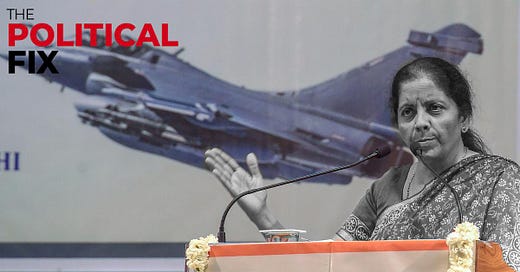The Political Fix: Why did India drop anti-corruption clauses in the Rafale Deal?
A newsletter on Indian politics and policy from Scroll.in.
Welcome to The Political Fix by Rohan Venkataramakrishnan, a newsletter on Indian politics and policy. To get it in your inbox every week, sign up here.
We don’t charge for this newsletter, but if you would like to support us consider contributing to the Scroll Reporting Fund or, if you’re not in India, subscribing to Scroll+.
The Big Story: Clause wits
Public memory of the Rafale affair appears to be closely connected to the unsuccessful effort by the Congress – or more specifically former Congress President Rahul Gandhi – to turn the fighter jet deal into a corruption case that might change voter perceptions ahead of the 2019 general elections. Remember the “chowkidar chor hai” slogan, implying Prime Minister Narendra Modi is a thief? That effort evidently failed.
But it is important to remember that the controversy around the procurement of the French fighter jet began because of the Bharatiya Janata Party’s own claims.
To recap: India had been looking to buy new fighter jets since 2007 to replace its aging MiG 21 squadrons.
The Congress-led government had, after issuing a global tender for 126 planes, honed in on the Rafale, built by France’s Dassault. The deal would have resulted in18 Rafale jets coming directly from France, while the rest would have to be built in India. But in 2014 when Modi came to power, negotiations had yet to be completed.
In 2015, on a visit to France, Modi ripped up that deal. Instead, he announced that India would buy 36 Rafale jets instead of the original 126. All of them would be built in France.
Modi’s government and his supporters went to town attempting to portray the prime minister as the sort of administrator able to conclude deals that had been pending for nearly a decade under his predecessor. They insisted that not only was this quicker, it would be a cheaper and better deal for India.
It is this claim that ultimately became controversial. The deal had certainly been concluded – but was it indeed quicker and better? Would the jets cost less under the new agreement? How had Dassault gone from working with India’s public sector Hindustan Aeronautics under the old agreement to collaborating with Anil Ambani’s Reliance group under Modi’s deal?
To pick up one element: the overall price of the deal signed in 2016 would see India spending Rs 58,000 crore for 36 jets, which using simple division (though the actual details may not break down that way) comes to Rs 1,600 crore per jet. The Congress claimed its government had negotiated a much cheaper Rs 526 crore per jet.
Most jarringly, in 2017, then Defence Minister Nirmala Sitharaman said the following after the Congress had raised questions about the price:
“I’m not running away from giving you specific numbers…We will give you... I don’t mind about the cost and the amount which is being paid, agreed to be paid, because those are public money….
Even on price, we have obtained the deal for the 36 which is far better than what they would have obtained per aircraft… I think to bicker on the cost, which I can anytime prove that we’ve obtained a better price, but to bicker on that as though they’ve served the interest of the preparedness and we are not doing it is, I’m sorry to use sharp words, shameful.”
Yet, months later, Sitharaman refused to disclose the per-jet price to Parliament, fueling even more controversy.
There are a lot of complex details here, so if you’re curious, read our many pieces on the subject:
The Modi Years: Why is the flagship Rafale deal still controversial?
Is India paying more for the fighter jet than it would have under UPA?
How are Anil Ambani and Reliance involved in the controversial deal?
Can Modi explain this fundamental contradiction in Centre’s stand on the Rafale deal?
Did Narendra Modi’s PMO interfere with negotiations over the jets?
A flawed Supreme Court decision in 2018 and the results of the 2019 general election took the Rafale case away from the headlines. But the many unsettling questions about the deal had not disappeared: they were just less politically relevant.
Last week, a three-part series of reports by French investigative journalism outlet Mediapart on the deal only confirmed the initial impression. There may be no big smoking gun involving corruption of the sort that Rahul Gandhi hoped could sink Modi. But there are enough indications that the Indian government cut corners in its hurry to sign a quick deal while also throwing Anil Ambani’s Reliance into the mix.
The first report finds that Dassault agreed to pay 1 million euros to a middleman also accused in the Congress-era ‘Choppergate’ case.
The second explains how the former head of the French public prosecution overruled a deputy and chose not to investigate allegations of corruption in the Rafale deal.
The third cites documents from India’s Enforcement Directorate to prove that Indian authorities sat on evidence of millions being paid by Dassault to the middleman – in the Congress years – in connection with the Rafale Deal, but did not open an investigation.
Each of these adds a little more to our picture of the complex inter-governmental defence deal, even if it doesn’t fundamentally alter the political conditions. The first highlights yet another unsettling part of the overall arrangement – why was Dassault paying a company to build car-sized replica models of its jets that were never actually seen? The second adds information about the blind eye of the French authorities.
But it is the third report that sheds some light on one of those corners that were cut by the Indian side. The Hindu had reported in 2019 that the Indian government had, very unusually, dropped “standard Defence Procurement Procedure clauses on ‘Penalty for use of Undue Influence, Agents/Agency Commission, and Access to Company accounts’” in the supply protocols. That detail, along with India choosing to do away with a sovereign or bank guarantee from France, was one of many that raised the question: why do this at all, unless something more unsettling was going on?
In light of the Mediapart report, the most innocent explanation may be that the Indian government had evidence of Dassault working with middlemen in an earlier era, and didn’t want that to come back and bite the company. Of course, dropping of anti-corruption clauses in defence deals could lead to much more unsavoury conclusions as well.
And as former Controller General of Defence Accounts and Financial Adviser, Defence Services Sudhansu Mohanty writes, these revelations put India in a very uncomfortable place – not least because there is still a potential deal for 114 fighter jets yet to be signed:
“The logical question is this: what if Dassault is implicated in the case for illegally engaging an agent and practicing unholy business practices proscribed by the DPP 2013? Can the government of India, despite waiving the anti-corruption clause from the body of the Rafale contract, implicate the company and refuse to entertain their RFI?
And, on the contrary, if they do go ahead, how will that action go down in the global defence market? Either way, it seems we are in a bind. But one thing seems fairly clear: the future MMRCA purchase will be at a far higher price mark, and India’s long and vaunted history of murky defence deals shall stand more sullied than before. Like one lie forcing another lie and yet another leading to serial lies, one serious departure from the prescribed integrity pact will not only spawn many more of its kind but will make India pay dearly in terms of loss of face and in more haemorrhaging of taxpayer money.”
Other headlines
India’s second Covid-19 wave is massive. It is most likely that this is powered by variants of the virus. And, with Maharashtra looking at a state-wide lockdown and numbers spiking everywhere, it is hard to say where the peak of this wave could be or what it will mean for migrants (who are again beginning to return home), state governments or the Indian economy.
This spike has also put pressure on the Centre, which for long was able to balance out its roles as guardian of the Indian people as well as vaccine factory to the world. Vaccine shortages around the country this week, however, led to many questions about India’s decision to export millions of doses. The response was a shockingly political tirade from the Union Health Minister, which I wrote about at length here:
“While it may seem secondary at the time of the second wave, Modi’s priorities undoubtedly included maintaining the reputation of India vaccination manufacturing industry, which would struggle if it begins reneging wholesale on global commitments – especially to other developing nations.
But from a domestic politics perspective, it seemed clear that the government appeared vulnerable to the question of whether its vaccine export policy had failed its own citizens. So it immediately tried to make it seem as if any questions about shortages were politically motivated and not genuine.
As more stories of shortages emerged, however, this tactic seemed unlikely to succeed.”
Interview: Indians shouldn’t believe the myth that the country’s Covid-19 mortality rate is low.
West Bengal elections: BJP’s fixation with TMC defectors sees party shoot itself in the foot in Singur.
The big foreign policy hubbub of the last few days was the US Navy’s decision to conduct a patrol in India’s Exclusive Economic Zone, west of Lakshadweep, without requesting prior permission challenging what Washington DC’s calls “excessive maritime claims”. We’ll have more on this inter-Quad squabble later this week.
Can’t make this up
To return to the Royals…
Thanks for reading the Political Fix. Send feedback to rohan@scroll.in.
Support our journalism by subscribing to Scroll+. We welcome your comments at letters@scroll.in.






